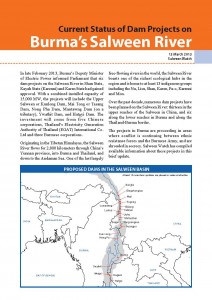Current Status of Dam Projects on Burma’s Salween River
By Salween Watch • March 13, 2013 In late February 2013, Burma’s Deputy Minister of Electric Power informed Parliament that six dam projects on the Salween River in Shan State, Kayah State (Karenni) and Karen State had gained approval. With a combined installed capacity of 15,000 MW, the projects will include the Upper Salween or Kunlong Dam, Mai Tong or Tasang Dam, Nong Pha Dam, Mantawng Dam (on a tributary), Ywathit Dam, and Hatgyi Dam. The investment will come from five Chinese corporations, Thailand’s Electricity Generation Authority of Thailand (EGAT) International Co. Ltd and three Burmese corporations.
In late February 2013, Burma’s Deputy Minister of Electric Power informed Parliament that six dam projects on the Salween River in Shan State, Kayah State (Karenni) and Karen State had gained approval. With a combined installed capacity of 15,000 MW, the projects will include the Upper Salween or Kunlong Dam, Mai Tong or Tasang Dam, Nong Pha Dam, Mantawng Dam (on a tributary), Ywathit Dam, and Hatgyi Dam. The investment will come from five Chinese corporations, Thailand’s Electricity Generation Authority of Thailand (EGAT) International Co. Ltd and three Burmese corporations.
Originating in the Tibetan Himalayas, the Salween River flows for 2,800 kilometers through China’s Yunnan province, into Burma and Thailand, and down to the Andaman Sea. One of the last largely free-fl owing rivers in the world, the Salween River boasts one of the richest ecological hubs in the region and is home to at least 13 indigenous groups including the Nu, Lisu, Shan, Karen, Pa-o, Karenni and Mon.
Over the past decade, numerous dam projects have been planned on the Salween River: thirteen in the upper reaches of the Salween in China, and six along the lower reaches in Burma and along the Thailand-Burma border. The projects in Burma are proceeding in areas where conflict is continuing between ethnic resistance forces and the Burmese Army, and are shrouded in secrecy. Salween Watch has compiled available information about these projects in this brief update.
Download the full briefer here.
Tags: China, Dams, Environment, Investment, Salween River, Salween Watch, ThailandThis post is in: Business and Human Rights, Environmental and Economic Justice
Related PostsChina’s Engagement in Myanmar: From Malacca Dilemma to Transition Dilemma
Rivers of Green Blood
Cash from chaos: The Burgeoning Illicit Trade in Timber from Myanmar to China revealed
Organized Chaos: The illicit overland timber trade between Burma and China
Shans Present 23,717 Signatures against Salween Dams to Australian Consultants in Yangon









 All posts
All posts